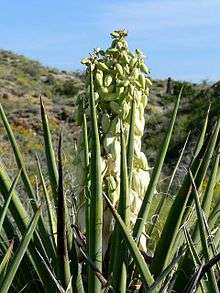Yucca schidigera
| Yucca schidigera Mojave yucca | |
|---|---|
 | |
| Flowering plant, Palm Canyon, California | |
| Scientific classification | |
| Kingdom: | Plantae |
| Clade: | Angiosperms |
| Clade: | Monocots |
| Order: | Asparagales |
| Family: | Asparagaceae |
| Subfamily: | Agavoideae |
| Genus: | Yucca |
| Species: | Y. schidigera |
| Binomial name | |
| Yucca schidigera Roezl ex Ortgies | |
| Synonyms[1] | |
| |
Yucca schidigera, also known as the Mojave yucca or Spanish dagger, is a flowering plant that is native to the Mojave Desert, Chihuahuan Desert and Sonoran Desert of southeastern California, Baja California, New Mexico, southern Nevada and Arizona.
This yucca typically grows on rocky desert slopes and creosote desert flats between 300–1,200 metres (980–3,940 ft) altitude, rarely up to 2,500 metres (8,200 ft). They thrive in full sun and in soil with excellent drainage. It also needs no summer water. It is related to the Banana yucca (Yucca baccata), which occurs in the same general area; hybrids between the two are sometimes found.
Description

Yucca schidigera is a small evergreen tree growing to 5 metres (16 ft) tall, with a dense crown of spirally arranged bayonet-like leaves on top of a conspicuous basal trunk. The bark is gray-brown, being covered with brown dead leaves near the top, becoming irregularly rough and scaly-to-ridged closer to the ground. The leaves are 30–150 cm long and 4–11 cm broad at the base, concavo-convex, thick, very rigid, and yellow-green to blue-green in color.
The flowers are white, sometimes having a purple tinge, bell-shaped, 3–5 cm long (rarely to 7.5 cm), produced in a compact, bulbous cluster 60–120 cm tall at the top of the stem. The fruit is an elongate berry, up to 11.5 cm long.[2][3]
Uses
The fibers of the Yucca schidigera leaves were used by Native Americans to make rope, sandals, and cloth. The flowers and fruit could be eaten and the black seeds were ground into a flour. The roots were used to make soap.
Some reports claim that Native Americans washed their hair with yucca to fight dandruff and hair loss. Among the other maladies this yucca has been used to treat are headaches, bleeding, gonorrhea, arthritis and rheumatism.
Currently extracts from this plant are in animal feed and various herbal medications. The rigid flower stalk of the yucca, after maturation, is used as a substitute for eucalyptus stems or logs to make didgeridoos. It is also used as a natural deodorizer, and is used in pet deodorizers. Steroid saponins are produced commercially from Yucca schidigera.
References
- Fritz Hochstätter (ed.): Yucca (Agavaceae). Band 1 Dehiscent-fruited species in the Southwest and Midwest of the USA, Canada and Baja California , Selbst Verlag, 2000. ISBN 3-00-005946-6
- Fritz Hochstätter (ed.): Yucca (Agavaceae). Band 2 Indehiscent-fruited species in the Southwest, Midwest and East of the USA, Selbst Verlag. 2002. ISBN 3-00-009008-8
- Fritz Hochstätter (ed.): Yucca (Agavaceae). Band 3 Mexico , Selbst Verlag, 2004. ISBN 3-00-013124-8
- Foster, S.; Duke, J. A. (1990). A Field Guide to Medicinal Plants: Eastern and Central North America. Boston: Houghton Mifflin. ISBN 0-395-46722-5.
- Francis, George; Kerem, Zohar; Makkar, Harinder P. S.; Becker, Klaus (2002). "The biological action of saponins in animal systems: a review". British Journal of Nutrition. 88 (6): 587–605. doi:10.1079/BJN2002725. PMID 12493081.
External links
| Wikimedia Commons has media related to Yucca schidigera. |
- Flora of North America: Yucca schidigera
- Jepson Flora Project: Yucca schidigera
- Desert USA entry for Mojave Yucca
- Common names of yucca species
- Yucca I Verbreitungskarte I Fritz Hochstätter | Yucca schidigera photos
- Photos of Yucca schidigera by Keir Morse
- Additional info on the Mojave Yucca